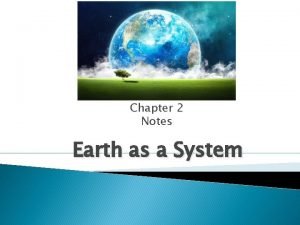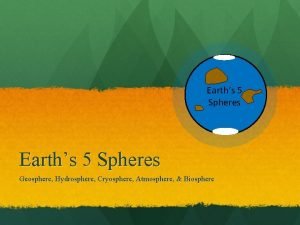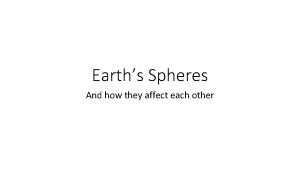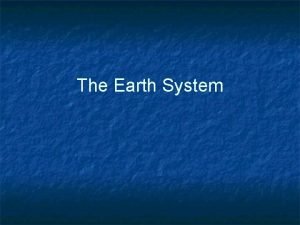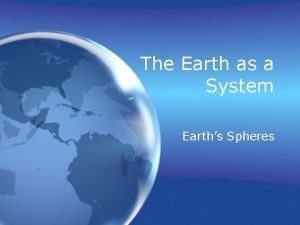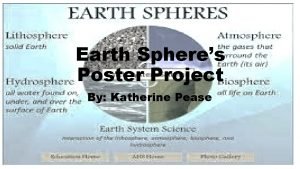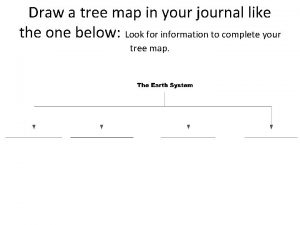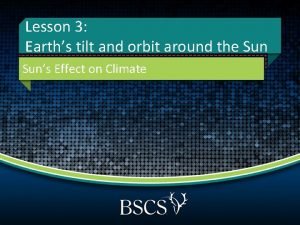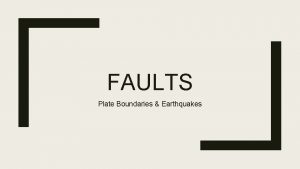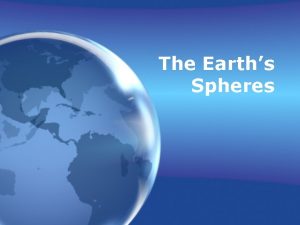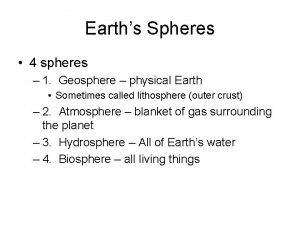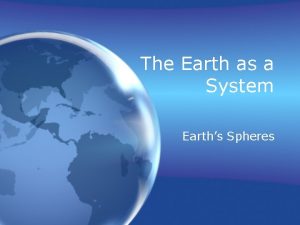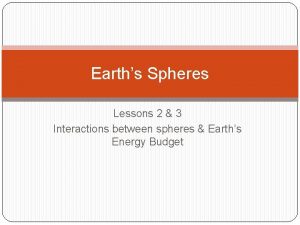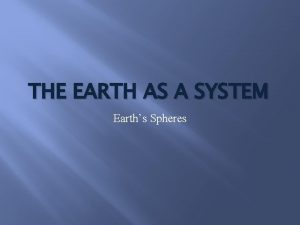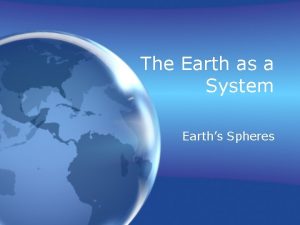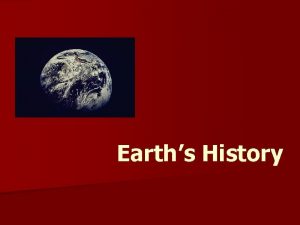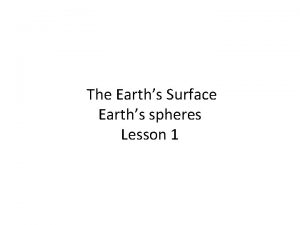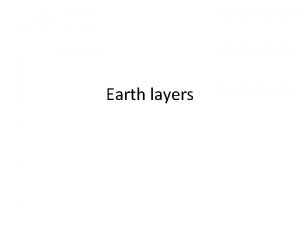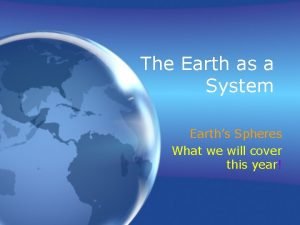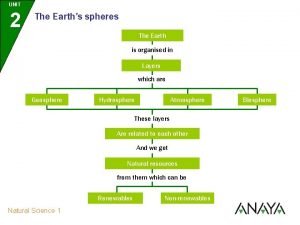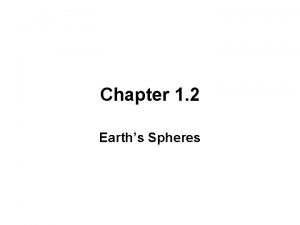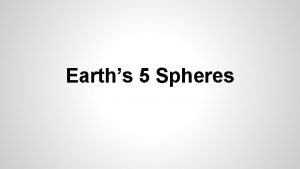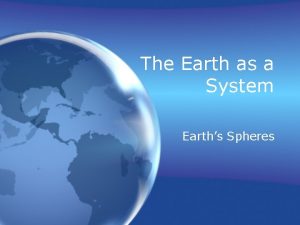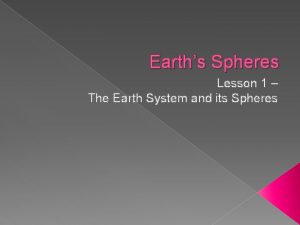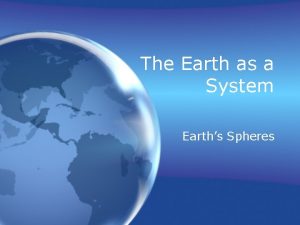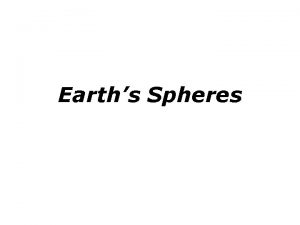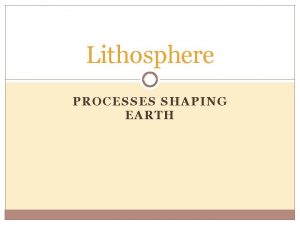The Earths Spheres n n n The Earth
























- Slides: 24

The Earth’s Spheres n n n The Earth is separated into different layers or spheres. Each sphere has different observable properties or characteristics such as temperature and composition. Each layer is held together due to gravity. Each layer has a different density. The farther from the center of the Earth you are, the less dense the layer. The three main spheres are the atmosphere, hydrosphere and the lithosphere.


The Structure of Earth from Surface to Outer Atmosphere Ø Spheres of Earth The first sphere we will discuss is called the ATMOSPHERE. Ø The atmosphere is a layer of gas composed primarily of 78% nitrogen and 21% oxygen that surrounds the Earth’s surface and is 1000 km thick. Ø Other gases that make up the remainder of the atmosphere are water vapor, carbon dioxide, argon, ozone, neon and a few other gases.


Discussing the structure of the atmosphere ØThe layer closest to the Earth’s surface where nearly all weather occurs is called the TROPOSPHERE. The layer with most of the water vapor. (ESRT pg 14). This is the densest layer of the atmosphere and contains the gases necessary for us to breath. When we pollute our atmosphere with toxic gases we are polluting the air that we breath. ØIncreasing the amount of CO 2, increases the temperature.


Ø Ø Ø The atmosphere is stratified or layered and the layers are separated by something called a pause. As we travel upward through the atmosphere, at about 10 km we cross through the tropopause and enter the next layer of the atmosphere called the STRATOSPHERE. Horizontal winds and lack of storms help with air travel

Atmosphere Cont. Ø The stratosphere is a layer that is approximately 20 km thick and contains an important gas called OZONE.


n n Ozone is a gas that protects Earth from harmful ultraviolet radiation. The ozone absorbs the ultraviolet radiation. Due to the absorption the temperature in the stratosphere increases.

Ø Ø The ozone layer is being reduced by human emissions of chlorine and fluorine, creating “Ozone Holes”. Top Image 2000 and Bottom Image 2006

Atmosphere Cont. Ø Ø As we continue our journey upward and leave the stratosphere we cross through the stratopause and enter the MESOSPHERE. The MESOSPHERE is approximately 30 km thick and is the middle layer (meso means middle) of the atmosphere. This where meteors burn up creating shooting stars.

Ø A we leave the mesosphere behind and cross through the mesopause we enter the THERMOSPHERE. Ø The thermosphere is a layer of the atmosphere of very high temperatures and is approximately 50 km thick. Ø Thermosphere is where the aurora occurs.

Things to remember about the atmosphere Ø Almost everything you need to know about the atmosphere is in the ESRT page 14. Ø Example: Order of layers, temperature changes within the layers, density of the layers, air pressure, water vapor concentration.

Atmosphere Video

ESRT Question on Atmosphere n In what layer of the atmosphere is the temperature at it’s lowest? n As you increase in altitude from sea level, what happens to the atmospheric pressure? n What is the temperature at the tropopause?

Hydrosphere n n n The next sphere of the Earth is the hydrosphere, or the water layer. The hydrosphere lies between the atmosphere and the upper layer of the Earth’s interior. The hydrosphere covers approximately 70 percent of the earth. It includes the oceans, rivers, lakes and streams. Both freshwater and saltwater make up the hydrosphere.

Hydrosphere cont. n The hydrosphere is relatively thin, averaging about 3. 8 km in thickness. n Composed of mostly hydrogen and oxygen, with some varying amounts of dissolved gases and suspended solids.


Lithosphere n n n The lithosphere is the rock layer of the Earth. Is the solid outer shell at the top of the Earth’s interior. Found below the atmosphere and the hydrosphere. The lithosphere is about 100 km thick and is divided into different plates. The upper portion is called the crust. ESRT Link




 Earths 4 spheres
Earths 4 spheres Earth's spheres foldable
Earth's spheres foldable Cryosphere hydrosphere biosphere geosphere and atmosphere
Cryosphere hydrosphere biosphere geosphere and atmosphere Convergent plate boundaries
Convergent plate boundaries Geosphere and atmosphere
Geosphere and atmosphere Earth's spheres foldable
Earth's spheres foldable Earth's spheres
Earth's spheres How can you compare the terrarium to an earth system
How can you compare the terrarium to an earth system The different spheres
The different spheres Earth spheres poster
Earth spheres poster Spheres of the earth concept map
Spheres of the earth concept map What are the four spheres of the earth
What are the four spheres of the earth What are sphere interactions
What are sphere interactions Spring earth tilt
Spring earth tilt Earths mantle
Earths mantle Earth's layer foldable
Earth's layer foldable Whats a natural satellite
Whats a natural satellite Earths roation
Earths roation What does earths tilt do
What does earths tilt do Study of earth's physical features
Study of earth's physical features Whats earths moon called
Whats earths moon called Description of earth's atmosphere
Description of earth's atmosphere Earths major crustal plates
Earths major crustal plates Biome near the equator
Biome near the equator Earths boundaries
Earths boundaries

